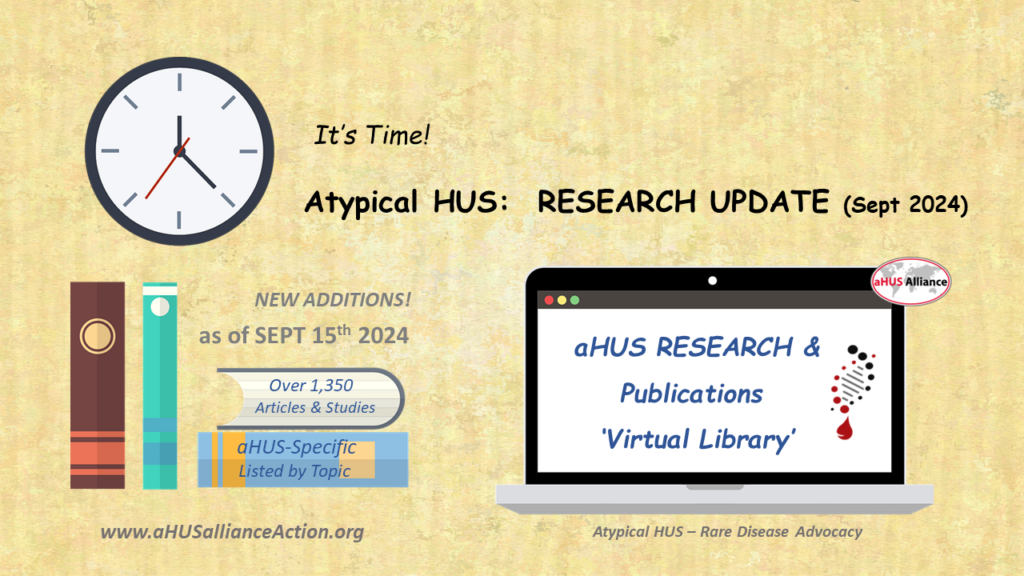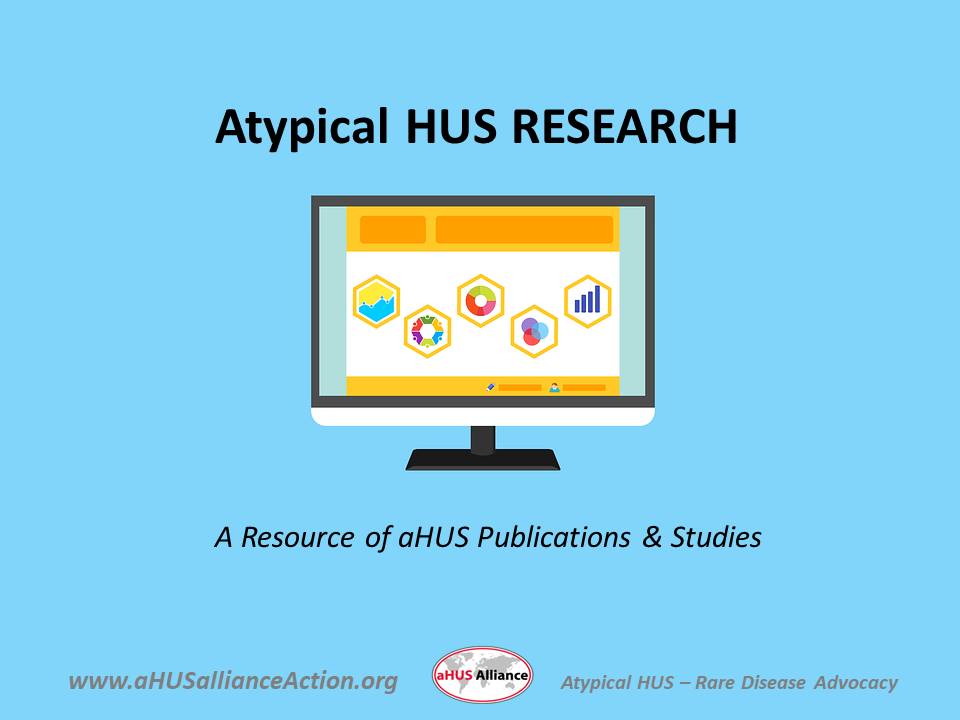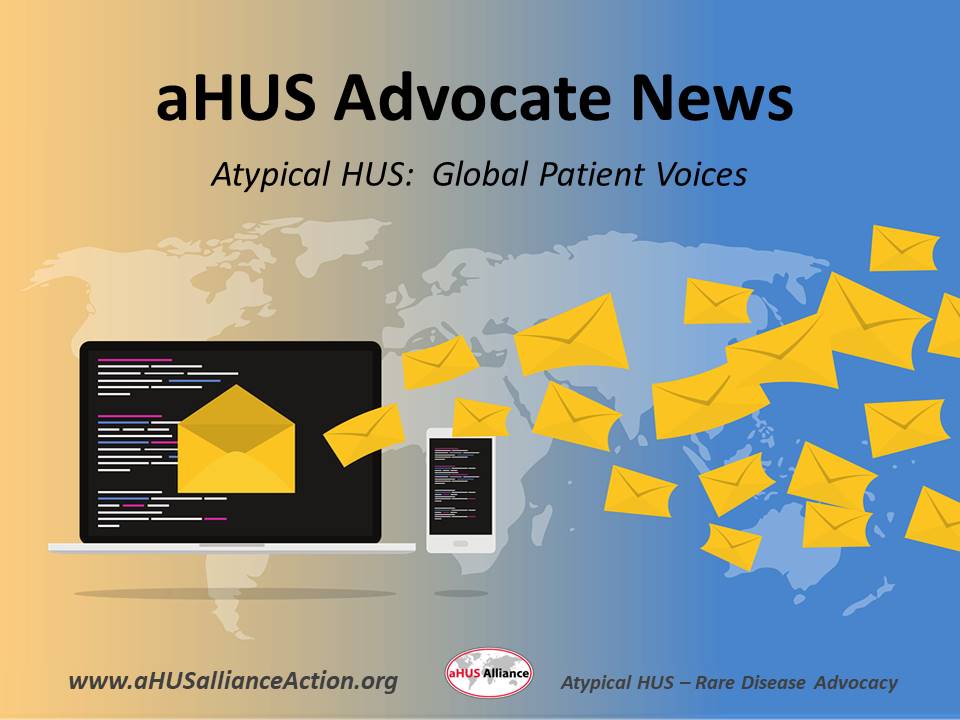
Every year since the first aHUS Awareness Day on 24 Sept 2015 we’ve attempted to shine a spotlight on atypical HUS research to help add more visibility to (and for) the aHUS community. A few years ago, the aHUS Alliance Global Action team created a ‘virtual library’ of publications specifically related to the rare disease atypical hemolytic uremic syndrome.
Some might think it an ambitious goal far beyond our international group of volunteers, who are ‘only’ aHUS patients and family caregivers. Yet in less than 10 years we’ve established a repository of categorized research that’s closing in on 1,400 publications. If we don’t set goals for accomplishments such as this curated accumulation of aHUS-related publications, as a tool to help ourselves keep pace with medical advancements and new therapeutic discoveries, who would do so?
Historic Highlights: Our newest Research Scroll
Our aHUS Research and Publications page features a new topic that captures the spirit of aHUS Awareness Day. On the 70th anniversary of the first patient to be officially diagnosed using the clinical term ‘haemolytic uraemic syndrome’, Len Woodward released the well-researched article ‘The Life and Works of Conrad von Gasser’ detailing the early history of discovery for this complex rare disease. Sadly the infant at a Swiss hospital did not survive, but this medical case is historically significant in that “hämolytisch-urämische syndrome” (German) was typed on her official medical report as Conrad von Gasser’s diagnosis. Subsequently, three other children were diagnosed at the same hospital (and later a fifth child elsewhere) to form the first aHUS patient group studied (cohort). These cases were presented with findings and in 1955 were published in a medical journal. With a bit of assistance, and thanks to the kindness of donors contributing to the aHUS Alliance Global Action charity, Len was able to uncover the original German article and have it professionally translated into English. As part of Len’s series ‘Before aHUS Endeavours Fade’, von Gasser’s work strongly influenced later developments discovery and treatment for atypical HUS. We greatly appreciate the time and effort behind Len’s achievement to return von Gasser’s work into the public domain – well done!
See all 3 articles on Conrad von Gasser’s life and work, fast track to our newest research scroll in our virtual library: Click Here (jump link) for direct access to that section of our Publications & Research page.
Time for Precision Medicine & an Individualized Approach for Patients?
As mentioned in our June article noting highlights of new research, there are still many knowledge gaps across aHUS topics and scientific understanding of the disease itself. It’s important for patients and their families to understand that there are many areas which continue to be debated by the experts, clearly noting that the science of aHUS is best framed as having plenty of gray areas rather than thinking in terms of ‘black and white’. If we better understand the nuances of atypical aHUS as a disease, as well as finding new ways to specifically identify and quantify precisely what’s going on with each patient, medical teams will be able to target treatment with a personalized approach to crafting an individualized care plan.
Atypical HUS seems more of a spectrum of disorders, with various causes (etiologies) and differences in clinical profiles. Even in a single family, with siblings sharing the same biologic parents, the children may have very different onset ages, medical experiences. and patient outcomes. But what if scientific advancements let us sort the different sub-types of aHUS, classify them by name, and then discover what drugs and disease management worked best for each type of aHUS? That’s what’s behind all the buzz about ‘nomenclature’.
In June, we highlighted the release of a very important new publication, The role of complement in kidney disease: conclusions from a Kidney Disease: Improving Global Outcomes (KDIGO) Controversies Conference (Vivarelli et al, 2024). In 2022 a panel of experts met in Italy to discuss ‘The Role of Complement in Kidney Disease’ and this publication is its result. This 70 page document covers the spectrum of issues related to the diagnosis and treatment of kidney diseases such as aHUS, C3 glomerulopathy, and more. (FMI on its impact, read our overview.) These KDIGO guidelines for aHUS will guide doctors and clinical practice around the world.
Atypical HUS as an ‘umbrella term’: What’s in a Name?
Last things first, in this case to frame the importance of a publication just released (Sept 2024) by an international panel of aHUS experts. Take a look at the full list of authors cited for the September 2024 publication from the National Kidney Foundation’s team of working groups, and you’ll find many ‘top names’ in aHUS / TMA research and clinical practice from around the world.
Nester CM, Feldman DL, Burwick R, Cataland S, Chaturvedi S, Cook HT, Cuker A, Dixon BP, Fakhouri F, Hingorani SR, Java A, van de Kar NCAJ, Kavanagh D, Leung N, Licht C, Noris M, O’Shaughnessy MM, Parikh SV, Peyandi F, Remuzzi G, Smith RJH, Sperati CJ, Waldman M, Walker P, Vivarelli M. An expert discussion on the atypical hemolytic uremic syndrome nomenclature-identifying a road map to precision: a report of a National Kidney Foundation Working Group. Kidney Int. 2024 Sep;106(3):326-336. doi: 10.1016/j.kint.2024.05.021. PMID: 39174192.
With new advancements in medicine comes broadening of opportunities that may be ‘game changes’ for diagnosis and treatment. This is especially true for the over 6,000 rare disease groups, to include atypical HUS. We’re at an exciting yet challenging time, since many knowledge gaps are being bridged thanks not only to scientific discoveries but also with increased collaboration among international aHUS experts. T
It has become increasingly apparent that there’s no single clinical profile for aHUS as a medical condition. People may experience aHUS as episodes of varying length, or as an ongoing and chronic illness. Organ function may be slightly to severely damaged, and while kidneys always take a ‘hit’, aHUS activity can impact any organ to include the heart, lungs, GI tract, brain or CNS, eyes, skin as well as other body systems. So why do some aHUS patients experience this rare disease so differently, and why do their responses to treatment vary?
Researchers and clinicians are beginning to consider ‘atypical HUS’ as more of an umbrella term, as clinical variations that indicate that there are sub-types of aHUS. Whether we think of aHUS as ‘spectrum of disorders’ or as an ‘aHUS group’, the science is clear – it’s time to consider ‘What type of atypical HUS?” when determining aHUS treatment and disease management. Better patient outcomes await if physicians can more accurately diagnose and precisely target the best treatments and managed care approaches, by identifying the cause of the disease (or etiology, such as infection, pregnancy, an auto-immune condition).
It’s heartening to see a coordinated and global effort to improve care and patient prognosis in all areas of disease management, from diagnosis to pregnancy to managing relapse risk decisions. With new advancements in medicine, in drug development, in better understanding complement and genetics here’s the basic idea – we know know that there are different types of ‘atypical HUS’ and therefore there cannot be a ‘one treatment fits all’ approach. It simply doesn’t work. And know that we ‘know better’, we need to better classify the distinct characteristics of the disease for the patient in order to precisely optimize care and target aHUS management with the greatest chance to build a better future for that individual. Precision medicine for each person will mean that their medical team will need to find a more specific label (aka ‘nomenclature’) to do so. Hand in hand with our next hightlight….
A Press Release on Precision Medicine & an Individualized Approach? Yes!
While technically a press release, we consider this publication a “Don’t Miss’ read. Why? It’s the rare document that informs the public of the impact a publication will have on patients and those who diagnose or treat them. Here’s a fine example of commentary that enlightens us about the real-life impact of the KDIGO controversies meeting held in Italy in 2022:
Key quotes from the press release, as Dr Marina Vivarelli (Italy) framed the conference:‘ “The discussions at this conference were incredibly enlightening,” said Dr. Vivarelli. “We delved into the roles of complement in both rare and common kidney diseases, identifying knowledge gaps and setting research priorities. The evidence clearly shows that activation or dysregulation of complement plays a role in the pathogenesis of an increasing array of kidney diseases.” and further added: “With more therapeutic agents becoming available that target different parts of the complement cascade, it is vital that we improve our ability to identify the relevant pathway or protein involved in each patient, characterize its role, and determine the best course in ceasing the aberrant complement activity.” ‘
Dr Richard Smith (USA: MORL, U of Iowa) reviewed future action steps among stakeholders with a vested interest, and it was rewarding to see that patient voices will play a valued role. ‘ “The conference also underscored the importance of a global, coordinated, and collaborative approach to improving patient treatment options and outcomes. “It is clear that we need a concerted, multinational effort to make meaningful progress in our understanding and treatment of these mostly rare and heterogeneous kidney diseases,” said Dr. Smith. “We need to identify biomarkers of complement activation and dysregulation, standardize their measurement, and promote their global implementation. Data on complement biomarkers should be widely disseminated, and all stakeholders, including patient and caregiver associations, medical societies, health authorities, and pharmaceutical companies, must synergize to promote registries, biobanks, data sharing, and open access to trial results. This collaborative approach will enable us to offer early, accurate diagnosis and safe, effective, and affordable treatment tailored to individual patients.” ‘
The aHUS Alliance Global Action team remains strong advocates for those affected by aHUS, and proudly partners with people and groups dedicated to shedding light on clinical care, filling in knowledge gaps, and working together to build a brighter future for those affected by this rare disease.

A ‘Virtual Library’ of aHUS-specific Research – What is that?
Often publications with advancements and insights into this very rare disease are scattered across medical journals related to nephrology and hematology specialties, but atypical HUS information can be found under varied terms and across specialty areas. That’s where we come in, since as aHUS patients and family caregivers ourselves we have a vested interest in staying up-to-date with current research. It’s likely that other families affected by aHUS may wish to key into a specific topic, so to aid navigation of our ‘Research and Publications’ page we’ve not only categorized entries but also have added links to jump to each Scroll (topic section) to speed your search.
Research articles about atypical HUS are listed within our website on topic-specific lists within our Info Centre, where you can see a list for “New Research” which are then also listed by category. Scroll topic categories are: New Research, Critical Care, Diagnosis, Treatment, Discontinuing Treatment/Relapse, Thrombotic Microangiopathy (TMA), Extra Renal (Effects on Organs other than Kidneys), Pregnancy, Transplants, Genetics, Complement, Secondary aHUS, Triggers, Research in Specific Nations, Case Studies, Patient Registries: Publications, Drug Discovery/Research, Summary Articles/Literature Reviews, Consensus Documents/Guidelines, and Varied Topics.
(Note: All entries from the ‘New Research’ scroll additionally are cross-listed at the start of each specific topic. While this ‘library’ has grown to over 1,400 unique publications, it results in about 1800 dual entries – such as a study that examines mutation impact on disease management, and thus listed on both Genetics and Treatment scrolls.)
Visit our ‘virtual library’ of almost 1,400 publications specific to aHUS
by clicking this link: Atypical HUS Research & Publications

Keeping Pace with Advancements: Are you ‘aHUS Aware’?
The aHUS Alliance Global Action team encourages researchers to release their studies and publications in full text versions, with Open Access to facilitate sharing knowledge. Additionally, we welcome and applaud those individuals and groups who include “Plain Language Versions” as part of their publication’s Supplementary Materials.
Are you staying current with aHUS research & News?
We invite you to subscribe to our free newsletter, The aHUS Global Advocate
For More about our Newsletter & reasons to Stay Connected
Click Here to Sign Up to receive the Newsletter

